
Shopping for marimbas but not quite sure what you’re looking for?
Or how to tell the difference between one and the next?
Well you’ve come to the right place.
Because in this ultimate guide, you’re going to get a crash course in everything a beginner should know about this instrument…and get some helpful product recommendations as well.
First up…
Marimbas vs Xylophones and the Rest: The Differences?
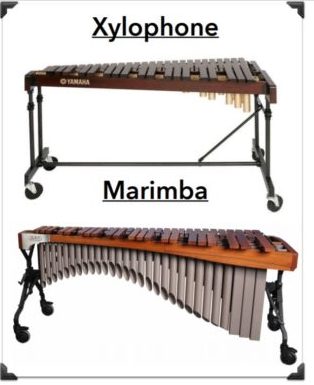
Marimbas are the largest of tone-plate instruments (glockenspiel, xylophone and vibraphone), with the widest note range.
Named after a Zulu goddess of a South African tribe…it’s been said that the goddess attached gourds to a xylophone to make it more resonant.
At some point, West-African slaves in Central and South America replaced the gourds with resonating tubes…which is the modern version of the instrument as we know it today.
The addition of these tubes makes the marimba’s sound louder, warmer, and fuller compared to other instruments in its class.
Therefore, despite being relatively unknown as an instrument, its sound can be heard in popular music far more often than you’d imagine.
Compared to its most famous counterpart, the xylophone:
- Marimbas are also larger – with a wider octave range
- And use soft mallets – vs the hard mallets of the xylophone
Up next…
Anatomy of the Marimba: What You Need to Know
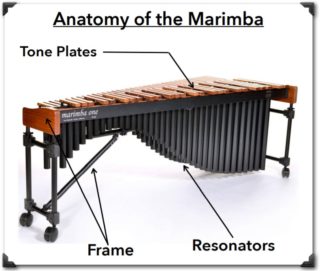
In terms of both sound and playability, there are 5 important subjects which every player must understand:
- Octave Range
- Wood vs Synthetic Tone Plates
- Graduated vs Non-Graduated Tone Plates
- Resonator Design
- Frame Design
So let’s begin now with #1…
Common Marimba Octave Ranges and Sizes
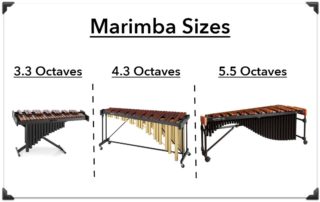
The marimba comes in 7 common sizes, named according their octave range:
- 3.3
- 4
- 4.3
- 4.5
- 4.6
- 5
- 5.5
Generally speaking…anything under 4.3 is not really consider full-size, and may prevent you from playing certain pieces of music.
So unless space or price is an issue, or you’re buying for a child, I wouldn’t recommend them.
On the other hand, a 5.5 is probably overkill for anyone new to the instrument. So try and pick something in the mid-range that best suits you.
Up next…
Wood vs Synthetic Tone Plates: What’s the Difference?
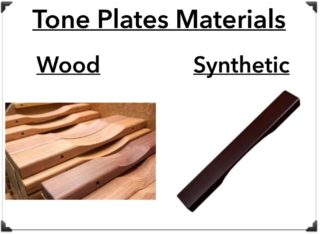
Traditionally, tone plates were made from wood, and even today, are still the overwhelming favorite.
The two standard woods used are:
- Rosewood – which has a warmer sound, and is most common on professional marimbas
- Padauk – which has a brighter sound, and can be found on both pro and student marimbas alike, but is generally much less common than rosewood
The only real alternative to these 2 woods, is synthetic tone plates, which do offer a number of potential advantages:
- Less Vulnerable to Weather – compared to wood, which can be particularly sensitive to changes in humidity.
- Less Expensive – which is great for beginners, since marimbas in general can be very expensive.
NOTE: The only company right now producing synthetic plates is Yamaha with their “Acoustalon” technology, that they say sounds similar to rosewood.
Up next…
Graduated vs. Non-Graduated Tone Plates: What’s the Difference?
If you’re unfamiliar with these two terms, here’s what they mean:
- Graduated – means their size increases as note decreases
- Non-Graduated – means their size is the same, across all octaves
Now, 99% of marimba players consider the larger graduated tone plates to be superior, since they are louder and offer a subjectively better tone….
And the offer currently available shows this trend, since marimbas for the overwhelming majority use graduated tone-bars.
No surprise, this means they are typically more expensive as well.
Up next…
Marimba Resonators: How They Affect Tone
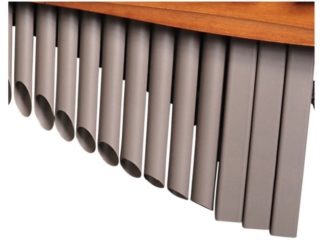
As we mentioned earlier, the resonators are the defining piece separating the marimba from other instruments in its class.
Their job is to improve the tone of the sound plates, in volume, sustain, and warmth.
And yet, not all resonators are the same.
They can be made out of either aluminum or brass, (although this difference is mostly aesthetic and has minimal impact on sound).
The much more important distinction between designs is the shape of the tube. The 3 common options are:
- Cylindrical – which is most common
- Cutaway/Flared – which are sometimes used to reduce weight
- Square – which is sometimes used on higher notes, to tame undesired harmonics and overtones.
Now…as physics would dictate, the lower the note, the longer the resonator. But as you’ll notice in some models, this doesn’t appear to be the case.
Because for aesthetic reasons, the higher note resonators are sometimes made to appear larger than their actual vibrating portion.
Some high-end resonators additionally feature an adjustable end-cap to control sustain.
Up next…
Height Adjustment Features on High-End Marimba Models
While cheaper marimba frames don’t offer much more than wheels…higher-end models will often feature various height adjustment options to accommodate players of various sizes.
- With Basic Models – the frame will have some sort of screw or mechanical height adjustment
- With Premium Models – you’ll often see a combination of pneumatic lifts, and premeasured height markings that make it easy quickly adjust the instrument to any player.
Up next…
442Hz vs 443Hz Tuning: What’s the Difference?
When comparing marimba models, you’ll notice that include the frequency to which the A is tuned.
You can either choose A=442Hz or A=443Hz. So what’s the difference?
Well to the human ear it is minimal – not to say indistinguishable, but to an orchestra or a band however it is not, and might result in unpleasant dissonance.
And so if you are planning on playing with other musicians, you’ll have to make sure all instruments are tuned to the same A frequency.
And so to avoid this headache, you’ll have to choose the right frequency when buying your marimba.
Note that some manufacturers take orders for other frequencies, sometimes anywhere from 440Hz to 445Hz.
Next up…
Our Top Recommended Marimbas
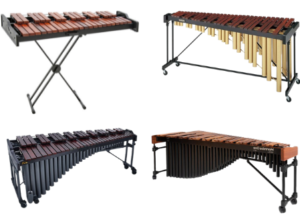
By now, we’ve pretty much covered everything a beginner might want to know when doing background research on this instrument.
So the only thing left to do at this point is to start using your new knowledge to compare different models.
To make this part easier, I’ve included a link list below of our top recommended models currently on the market, at a variety of price ranges. Here they are:
Non-gradutated tone bars marimbas
Under $3000:
- Thomann THM3.0 Practice Marimba – (Thomann)
Graduated tone-bars marimbas
Under $3000
From $3000 to $6000:
- Thomann Marimba by Bergerault Thm 4.3 – (Thomann)
- Yamaha YM-1430 – (Thomann)
- Bergerault MCHE Campus – (Thomann)
Above $6000
- Bergerault Marimba MCBH – (Thomann)
- Yamaha YM-2400 (Acoustalon tone plates) – (Thomann)
- Yamaha YM-5100 – (Thomann)
- Marimba One Izzy – (Thomann)
Up next…
What You Need to Know About Marimba Mallets
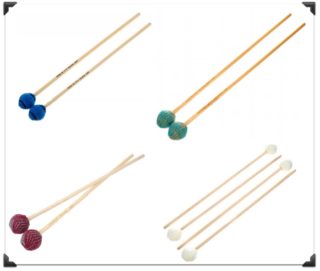
With marimba mallets, there several key factors that affect both sound and playability of the instrument.
The most notable ones being:
- Shaft Wood
- Head Hardness
- Mallet graduation
So here’s a little more about each one:
What Are Marimba Mallet Shafts Made From?
Typically, mallet shafts are made from either:
- Birch – which is a hard wood that produces stiff sticks
- the porous texture allows for good grip
- the rear weight distribution is ideal for the traditional grip
- Rattan – which is a softer wood and produces flexible sticks
- the flexibility is ideal for shock absorption for faster players
- the forward weight distribution and smooth texture is ideal for the Burton grip
Some players even like to combine these woods, with two Birch sticks in one hand, and two Rattan in the other.
Up next…
Soft vs Hard Mallet Heads: What’s the Difference?
The head of a marimba mallet is made of 2 parts:
- The inner core – which is the rubber center
- The outer wrapping – which is the wool, hemp, or synthetic yarn that covers the cover
For the most part, the sound and performance of these materials are minimal. Instead, the more important distinction is the overall hardness of the head.
As a rule of thumb:
- Softer mallets – have a warmer tone/softer attack
- Harder mallets – have a brighter tone/sharper attack
Up next…
So What Exactly is Mallet Graduation?
In the vast majority of cases, marimba players use a mix of mallet harnesses for each of their 4 sticks. This combination of mallets is known as mallet graduation.
Typically, mallet graduation starts with softer heads for the lower notes, and while gradually increasing hardness towards the higher notes.
Common combinations include:
- Soft/Medium/Medium/Hard – which is the most common and most versatile
- Soft/Medium/Hard/Hard – which is well-suited for playing in the higher octaves
- Soft/Medium/Medium/Medium – which is best suited for linear compositions
Now finally, to wrap up this post:
Our Top Recommended Marimba Mallets
At this point, we’ve covered all the important details you should know when comparison shopping for marimba mallets.
The only thing left to do now is start using your new knowledge to compare models.
So to make things easier for you, I’ve included a list of these top models below:
Under $40/Pair:
- Medium/Hard
- Medium
- Soft
- Adams MB6 – (Thomann)
Above $40/Pair:
- Medium-Hard
- Marimba One KMB3 – (Thomann)
- Medium
- Hard
By the way, if you found this post useful, I highly recommend joining our free Home Recording Secrets email newsletter where you’ll discover….
- How to Get Your First Studio Up and Running in a Single Weekend
- How to Avoid Wasting Thousands of Dollars on Unnecessary Pointless Purchases
- How to Get a “Million Dollar” Pro Studio Sound in a “Thousand Dollar” Home Studio
- PLUS… All Sorts of Other Amazing Insider Secrets Revealed
And it’s totally FREE! Click here and Enter Your Email to Sign Up.
More Drum/Percussion Posts in this Series:
Drum Sets | Electronic Drums | Snares | Drumheads | Cymbals | Djembe | Bongos | Cajon | Conga | Cowbell | Tambourines | Vibraphones | Xylophones | Marimbas | Glockenspiels | Metronomes | Drum Thrones | Drumsticks | Ride Cymbals